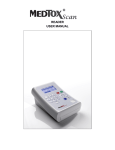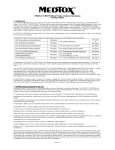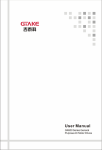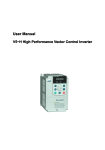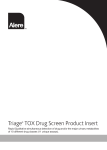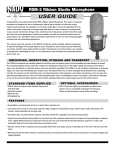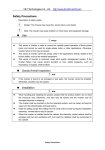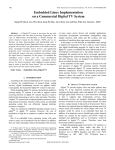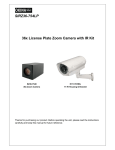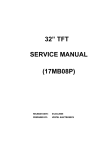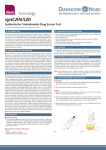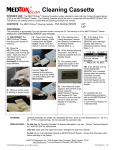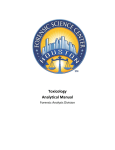Download PROFILE®-V MEDTOX Scan® Drugs of Abuse Test System
Transcript
PROFILE®-V MEDTOXScan® Drugs of Abuse Test System INSERT 1. INTENDED USE The PROFILE®-V MEDTOXScan® Drugs of Abuse Test System consists of the PROFILE®-V MEDTOXScan® Test Devices and the MEDTOXScan® Reader. The PROFILE®-V MEDTOXScan® Test Devices are one-step immunochromatographic tests for the rapid, qualitative detection of one or more of the following in human urine: Amphetamine, Barbiturates, Benzodiazepines, Cocaine, Methadone, Methamphetamine, Opiates, Phencyclidine and THC (Cannabinoids) or their metabolites. The PROFILE®-V MEDTOXScan® Test Devices can only be used with the MEDTOXScan® Reader. The MEDTOXScan® Reader is an instrument used to interpret and report the results of the PROFILE®-V MEDTOXScan® Test Device. The PROFILE®-V MEDTOXScan® Test Devices cannot be visually read. The PROFILE®-V MEDTOXScan® Drugs of Abuse Test System is for in vitro diagnostic use and is intended for professional use only. It is not intended for use in point-of-care settings. The PROFILE®-V MEDTOXScan® Drugs of Abuse Test System detects drug classes at the following cutoff concentrations: AMP Amphetamine (d-Amphetamine) 500 ng/mL MTD Methadone (Methadone) 200 ng/mL BAR Barbiturates (Butalbital) 200 ng/mL OPI Opiates (Morphine) 100 ng/mL BZO Benzodiazepines (Nordiazepam) 150 ng/mL PCP Phencyclidine (Phencyclidine) COC Cocaine (Benzoylecgonine) 150 ng/mL THC Cannabinoids (11-nor-9-carboxy- 9-THC) MAMP Methamphetamine (d-Methamphetamine) 500 ng/mL 25 ng/mL U 50 ng/mL Configurations of the PROFILE®-V MEDTOXScan® Test Devices may consist of any combination of the above listed drug analytes. Refer to specific product labeling for the combination of drug tests included on that test device. THE PROFILE®-V MEDTOXScan® DRUGS OF ABUSE TEST SYSTEM PROVIDES ONLY A PRELIMINARY ANALYTICAL TEST RESULT. A MORE SPECIFIC ALTERNATE CHEMICAL METHOD MUST BE USED IN ORDER TO OBTAIN A CONFIRMED ANALYTICAL RESULT. GAS CHROMATOGRAPHY / MASS SPECTROMETRY (GC/MS), HIGH PERFORMANCE LIQUID CHROMATOGRAPHY (HPLC) OR LIQUID CHROMATOGRAPHY / TANDEM MASS SPECTROMETRY (LC/MS/MS) ARE THE PREFERRED CONFIRMATORY METHODS. CLINICAL CONSIDERATION AND PROFESSIONAL JUDGMENT SHOULD BE APPLIED TO ANY DRUG OF ABUSE TEST RESULT, PARTICULARLY WHEN PRELIMINARY POSITIVE RESULTS ARE OBTAINED. The MEDTOXScan® Reader includes a Positive QC Test Device, a Negative QC Test Device and a Cleaning Cassette. The MEDTOXScan® Positive and Negative QC Test Devices are intended to detect errors associated with the MEDTOXScan® Reader and a contaminated contact imaging sensor (CIS), and to verify that the CIS cleaning procedure using the MEDTOXScan® Cleaning Cassette effectively removed any contamination (see “Troubleshooting” section). Information regarding confirmatory testing may be obtained from www.medtox.com or by contacting MEDTOX at 1-800-832-3244. 2. SUMMARY AND EXPLANATION OF THE TEST Qualitative PROFILE®-V MEDTOXScan® Test Devices utilize a one-step, solid-phase immunoassay technology. The PROFILE®-V MEDTOXScan® Drugs of Abuse Test System includes the MEDTOXScan® Reader for a convenient automated result. This test system may be used to screen urine samples for one or more of the following drug classes prior to confirmatory testing: The amphetamines are a group of drugs that are central nervous system stimulants. This group includes amphetamine and methamphetamine. Amphetamine (d-amphetamine) is detected on the Test Device only at the (AMP) position, methamphetamine (MAMP) is detected at the (MAMP) position. Barbiturates (BAR) are a group of structurally related prescription drugs that are used to reduce restlessness and emotional tension, induce sleep and to treat certain convulsive disorders. Benzodiazepines (BZO), a group of structurally related central nervous system depressants, are primarily used to reduce anxiety and induce sleep. Cocaine (COC) is a central nervous system stimulant. Its primary metabolite is benzoylecgonine. Methadone (MTD) is a synthetic opioid used clinically as a maintenance drug for opiate abusers and for pain management. Opiates (OPI) are a class of natural and semi-synthetic sedative narcotic drugs that include morphine, codeine and heroin. Phencyclidine (PCP) is a hallucinogenic drug. Marijuana (THC) is a hallucinogenic drug derived from the hemp plant. Marijuana contains a number of active ingredients collectively known as Cannabinoids. Many factors influence the length of time required for drugs to be metabolized and excreted in the urine. A variety of factors influence the time period during which drug metabolites are detected in urine. These include the rate of urine production, the volume of fluid consumption, the amount of drug taken, the urine pH, and the length of time over which drug was consumed. Drinking large volumes of liquid or using diuretics to increase urine volume will lower the drug concentration in the urine and may decrease the detection period. Lower detection levels may increase the detection time window. Although the detection period for these drugs varies widely depending upon the compound taken, dose and route of administration and individual rates of metabolism, some general times have been established and are listed below.1-5 Page 1 of 9 Drug Detection Period Drug Detection Period Amphetamine Acid Conditions Alkaline Condition 1-3 days 3-10 days Methamphetamine Acid Conditions Alkaline Conditions 1-3 days 3-10 days Barbiturates Short-Acting Long-Acting Up to 6 days Up to 16 days Opiates Heroin Morphine Codeine 1 day 1-3 days 1-3 days Benzodiazepines 1-12 days Cocaine metabolite Up to 5 days 1 to 3 days typical PCP Single Use Chronic Use 1-8 days Up to 4 weeks Methadone 1-3 days THC Single Use Chronic Use 1-7 days Less than 30 days typical 3. PRINCIPLES OF THE PROCEDURE The PROFILE®-V MEDTOXScan® Drugs of Abuse Test System includes the one-step, competitive, membrane-based immunochromatographic PROFILE®-V MEDTOXScan® Test Device and the MEDTOXScan® Reader, which interprets and reports the test results automatically. A single urine sample can be evaluated for the presence of each of the classes of drugs specified in a single PROFILE®-V MEDTOXScan® Test Device. The PROFILE®-V MEDTOXScan® Test Device includes antibody-colloidal gold, drug-conjugates and a control line. ANTIBODY-COLLOIDAL GOLD Mouse monoclonal antibodies were developed that bind specifically to the drug class being tested. The individual monoclonal antibodies were adsorbed to colloidal gold and dried onto the test device. DRUG-CONJUGATES Drugs from each class to be tested were individually conjugated to bovine serum albumin (BSA) or IgG. Each drug conjugate is immobilized on a test line at a designated position on the membrane strip. CONTROL LINE Each test strip has anti-mouse antibody immobilized at the Control (C) position of the membrane strip. The anti-mouse antibody will bind excess antibody-colloidal gold, indicating that the reagents are working properly. When the urine sample is placed in the sample well of a test strip, the dried antibody-colloidal gold on the sample pad dissolves and the urine wicks up the white strips carrying the reddish-purple antibody-colloidal gold with it. The PROFILE®-V MEDTOXScan® Drugs of Abuse Test System will detect specific classes of drugs in urine because drug(s) in the urine and the drug(s) conjugated to the protein compete to bind to the antibody-colloidal gold. A test line will form when drug in the sample is below the detection threshold (negative result). The MEDTOXScan® Reader scans the test device and utilizes a contact imaging sensor (CIS) to capture relative line intensities. Software algorithms and barcodes are used to identify the test device, the drug tests associated with the test device and whether the presence or absence of a line is associated with a negative or positive result, respectively. The results of the scans are displayed on the MEDTOXScan® Reader screen or, optionally, can be printed. Negative Samples When no drug(s) is present in the urine sample, the reddish purple antibody-colloidal gold solutions migrate along the strip and bind to the respective drug conjugate(s) immobilized on the membrane. Each strip has up to 4 drug test lines labeled T1 – T4. The binding of the antibody-colloidal gold to the drug conjugate generates a line at the corresponding test (T) position on the strip. The MEDTOXScan® Reader will scan each test position and if a line is detected it will return “NEG” on the display screen (or print out) next to the abbreviation for the drug test, indicating a negative result. Positive Samples When drug(s) is present in the urine sample the antibody-colloidal gold binds to the drug(s) before it migrates along the strip. When the antibodycolloidal gold binds to the drug(s) in the urine, it cannot bind to the drug conjugate immobilized on the membrane and no line is generated at the drugspecific position in the result window. The MEDTOXScan® Reader will scan each test position and if no line is detected it will return “POS” on the display screen (or print out) next to the abbreviation for the drug test, indicating a preliminary positive result. Control Line (Valid or Invalid results) Each test strip has an internal procedural control. A line must form at the Control (C) position in the result window to indicate that sufficient sample was applied and that the reagents are migrating properly. If a Control line does not form, the test is invalid. The MEDTOXScan® Reader scans each control line and returns “VALID” to the right of the drug test result to confirm that the control line was detected. If no control line is detected it will return “INVALID” on the display screen (or print out) next to the abbreviation for the invalid drug test, and no result will be given for that drug test. 4. SAMPLE COLLECTION AND PREPARATION The urine sample should be collected in a clean, dry container. Approximately 75 µL is required for each sample well. Collection of 30 mL of urine is more than sufficient for initial and subsequent testing. No preservatives should be added. Urine may be tested immediately following collection. If it is necessary to store the urine, store under refrigeration at 2 to 8°C (36 to 46° F) for no more than two days. Urine may be frozen at -20°C (-4° F) or colder for storage. Stored urine must be brought to ambient temperature (18 to 25°C/64 to 77°F) and mixed well to assure a homogeneous sample prior to testing. Page 2 of 9 5. PRECAUTIONS • The PROFILE®-V MEDTOXScan® Drugs of Abuse Test System is for in vitro diagnostic use only. • Do not use PROFILE®-V MEDTOXScan® Test Devices after the expiration date printed on the package label. • The PROFILE®-V MEDTOXScan® Test Device should remain in its original sealed foil pouch until ready to use. If the pouch is damaged, do not use the test. • If PROFILE®-V MEDTOXScan® Test Devices have been stored refrigerated, bring to ambient temperature (18-25°C/ 64-77°F) prior to opening foil pouch. • Do not store the test kit at temperatures above 25°C (77°F). Do not freeze. • Avoid cross-contamination of urine samples by using a new urine specimen container and a fresh pipette tip for each urine sample. • Do not touch test strips in large viewing window of the PROFILE®-V MEDTOXScan® Test Device. • Do not use PROFILE®-V MEDTOXScan® Test Device if strips are damaged or dirty. • Do not apply labels or tape to the PROFILE®-V MEDTOXScan® Test Device. • Do not write outside of the ID box on the PROFILE®-V MEDTOXScan® Test Device top. • Urine specimens and all materials coming in contact with them should be handled and disposed of as if infectious and capable of transmitting infection. Avoid contact with broken skin. • Avoid contaminating the top of the test device with urine sample. Clean any urine off the top of the test device using a dry wipe to prevent contamination of the MEDTOXScan® Reader sensor. 6. REAGENTS and MATERIALS PROVIDED/STORAGE CONDITIONS The PROFILE®-V MEDTOXScan® Drugs of Abuse Test System kit contains PROFILE®-V MEDTOXScan® Test Devices for use with the MEDTOXScan® Reader. • Each test device has all the reagents necessary to test one urine sample for one or more drugs simultaneously on the MEDTOXScan® Reader. • Each test device holds one or more test strips composed of a membrane strip coated with drug conjugate and a pad coated with antibodycolloidal gold in a protein matrix. Kit Contents 1. Twenty-five (25) test devices in individual foil packages 2. Twenty-five (25) disposable pipette tips 3. One Quick Reference guide Storage Conditions The kit, in its original packaging, should be stored at 2-25°C (36-77°F) until the expiration date on the label. MEDTOXScan® Reader Contents 1. Positive and Negative QC Test Devices 2. Cleaning Cassette 3. MiniPet pipettor 4. Quick Set Up guide 5. User Manual MATERIALS REQUIRED BUT NOT PROVIDED 1. Urine specimen collection container 2. PROFILE®-V MEDTOXScan® Positive and Negative Control Solutions (external controls) OPTIONAL MATERIALS 1. Thermal Printer and Printer paper 2. Hand held Barcode Scanner NOTE: Specimen containers and external control solutions are available from MEDTOX Diagnostics, Inc. 7. TEST PROCEDURE 1. 2. Open one pouch for each sample to be tested and mark the PROFILE®-V MEDTOXScan® Test Device with the patient or sample identification (ID). Make sure you only mark within the ID box on the test device. (You may notice a reddish-purple color in the sample well. This is normal, do not discard the test). Dispense 75µL of urine into sample well (indicated by V on the test device). • Place a disposable yellow sample tip securely onto the end of the green (75µL) MiniPet™. • Grasp the MiniPet under its collar using the index and middle fingers. With the thumb, depress the plunger completely. • Holding the MiniPet vertically (straight up-down), lower the yellow tip no more than ¼” into the urine specimen. • With tip in the urine specimen slowly and smoothly release the plunger allowing it to rise completely. • Visually inspect the urine sample in the tip. Ensure there are no air bubbles and that no excess urine is on the outer surface of the tip. • Hold the pipette tip directly over sample well. Depress plunger completely to dispense the entire contents of urine into one sample well of the testing device. 3. Repeat Step 2 for all sample wells with a V above them. 4. Discard disposable yellow sample tip. Store the MiniPet in a dry, secure location at room temperature (18 – 25 ºC or 64 – 77 ºF). Replace the MiniPet if it becomes damaged or does not function properly. 5. Place the test device in the MEDTOXScan® Reader cassette drawer and close the drawer. The MEDTOXScan® Reader will read the barcode on the test device and determine its part number and test configuration. It will prompt the user to enter Lot#, User ID#, and Specimen ID#, which can all be entered using the MEDTOXScan® Reader keypad or hand held barcode scanner. The MEDTOXScan® Reader will begin timing the assay once it detects the barcode and results will be displayed after the scan and analysis are complete. 6. Alternatively the reader can be set on “User Timed” mode, where it will scan the test device as soon as it detects its barcode (see MEDTOXScan® Reader User Manual). In this case the PROFILE®-V MEDTOXScan® Test Device should be inserted into the MEDTOXScan® Reader 10 minutes after adding the urine sample. MiniPet™ is a trademark of TriContinent Scientific, Inc. Page 3 of 9 8. READING AND INTERPRETATION OF THE TEST RESULTS The PROFILE®-V MEDTOXScan® Test Devices are labeled horizontally with the names of the test on each strip, and vertically with “C” and the symbols T1 – T4. The letter “C” represents the control lines. T1 – T4 refers to Test Position 1 to Test Position 4 from top to bottom of viewing window. The test position of each test is indicated on the label above the strip. The MEDTOXScan® Reader will automatically read the control and test lines at the correct test position and display the test results for each drug. A printer is also available. The MEDTOXScan® Reader displays the results as either “NEG” for a negative result, “POS” for a preliminary positive result, or “INVALID” for an invalid result. “VALID” will be displayed if valid results are obtained. Valid: The control line must be present for the test to be valid. NEG: A NEGATIVE test result for a specific drug indicates that the sample does not contain the drug/drug metabolite above the cutoff level. POS: A preliminary POSITIVE test result for a specific drug indicates that the sample may contain drug/drug metabolite near or above the cutoff level. It does not indicate the level of intoxication or the specific concentration of drug in the urine sample. Positive samples should be sent to a reference laboratory for more definitive testing. Invalid: The control line must be present for the test to be valid. The absence of a control line indicates the test is invalid. The urine sample should be retested on a new test device. 9. QUALITY CONTROL The purpose of quality control is to ensure accuracy and reliability of results and to detect errors. MEDTOX recommends a Quality Control Program for monitoring the performance of the PROFILE®-V MEDTOXScan® Test Devices and the MEDTOXScan® Reader that uses a combination of internal controls and external controls. Users should follow government regulations for the running of QC material. Internal controls ensure that the test is working and that you are performing the test correctly. A control line (internal control) is included on each PROFILE®-V MEDTOXScan® test strip. Whether or not drug is present in the sample, a line must form at the Control (C) position on the test strip to show that enough sample volume was used and that the reagents are migrating properly. If a Control line does not form, the test is invalid. The Control line consists of immobilized anti-mouse antibody that reacts with the antibody-colloidal gold as it passes this region of the membrane. Formation of a line detectable by the MEDTOXScan® Reader verifies the Control line antibody-antigen reaction occurred. External controls are urine-based control materials that contain the drugs to be tested at concentrations above the cutoff (positive control) or contain no drug (negative control). Run external controls as if they were patient samples. Refer to the instructions that accompany the external controls. You should run external controls routinely or as needed for any of the following reasons: (1) to practice the test with a known control, (2) when you open a new lot of devices, (3) once a week, (4) if you suspect that the reader or test device is not working properly, (5) if you have had a repeated unexpected test result, or (6) if you suspect that the test devices have been stored improperly. Should control results indicate a problem with the PROFILE®-V MEDTOXScan® Drugs of Abuse Test System, please follow the instructions in the Troubleshooting Section below. External quality control materials are available from MEDTOX. Contact MEDTOX at 1-800-832-3244 for further information. 10. LIMITATIONS OF THE PROCEDURE 1. The PROFILE®-V MEDTOXScan® Drugs of Abuse Test System is only for use with unadulterated human urine samples. Urine samples that are either extremely acidic (below pH 4.0) or basic (above pH 9.0) may produce erroneous results. If adulteration is suspected, obtain an additional specimen and re-test. 2. A presumptive positive result for any drug does not indicate the level of intoxication, administration route or concentration of that drug in the urine specimen. 3. A negative result may not necessarily indicate drug-free urine. Negative results can be obtained when drug is present but below the cut-off level of the test. 4. Test results detected by the MEDTOXScan® Reader after 10 minutes may not be consistent with the original result obtained at 10 minutes. 5. The PROFILE®-V MEDTOXScan® Drugs of Abuse Test System is not intended for use in point-of-care settings. 6. There is a possibility that other substances and/or factors, e.g. technical or procedural errors, may interfere with the test and cause false results. 7. Gas Chromatography/Mass Spectroscopy is the recommended confirmatory method for most drugs. HPLC or LC/MS/MS is the preferred confirmatory method for Benzodiazepines. Any of the drugs being tested for in the PROFILE®-V MEDTOXScan® Drugs of Abuse Test System may give a preliminary positive result if ingested at prescribed therapeutic doses. 8. The PROFILE®-V MEDTOXScan® Drugs of Abuse Test System cannot distinguish between abused drugs and certain prescribed medications. A positive test may be obtained from certain foods or food supplements. 9. The PROFILE®-V MEDTOXScan® Test Devices must be used only with the MEDTOXScan® Reader. They cannot be visually read. 11. PERFORMANCE CHARACTERISTICS Sensitivity The PROFILE®-V MEDTOXScan® Drugs of Abuse Test System detects one or more of the following drugs at cutoff levels listed below. AMP Amphetamine 500 ng/mL BAR Barbiturates (Butalbital) 200 ng/mL BZO Benzodiazepines (Nordiazepine) 150 ng/mL COC Benzoylecgonine 150 ng/mL MAMP Methamphetamine 500 ng/mL MTD Methadone 200 ng/mL OPI Morphine 100 ng/mL PCP Phencyclidine 25 ng/mL THC 11-nor-9-carboxy-∆9-THC 50 ng/mL Page 4 of 9 Accuracy Accuracy and Comparison to GC/MS or LC/MS/MS The accuracy of the PROFILE®-V MEDTOXScan® Drugs of Abuse Test System was evaluated by assaying a panel of blind coded clinical urine samples containing varying concentrations of drugs and comparing to GC/MS or LC/MS/MS results. The samples were obtained from MEDTOX Laboratories and grouped in the following manner: Negative samples that screened negative by KIMS (Kinetic Interaction of Microparticles in Solution), and not confirmed by GC/MS; Below Cutoff Negative samples that fell between limit of detection or quantitation and 50% of cutoff; Near Cutoff Negative samples that fell between 50% of the cutoff concentration and the cutoff concentration; Near Cutoff Positive samples that fell between the cutoff concentration and 150% of the cutoff concentration; and High Positive samples that were greater than 150% of cutoff concentration. Drug concentrations were assayed by GC/MS or LC/MS/MS for BZO. Concentrations used to assign the cutoff ranges for each drug were determined by summing the GC/MS and LC/MS/MS levels measured for all test-specific analytes found in the sample. The testing was performed by in-house operators. The results were interpreted at ten (10) minutes by the MEDTOXScan® Reader and are summarized for each drug in the table below. PROFILE®-V MEDTOXScan® Drugs of Abuse Test System Results vs. stratified GC/MS or LC/MS/MS Values DRUG AMP (500) BAR (200) BZO (150) COC (150) mAMP (500) MTD (200) OPI (100) PCP (25) THC (50) All Drugs P-V MEDTOXScan Test System No Drug Positive Negative Positive Negative Positive Negative Positive Negative Positive Negative Positive Negative Positive Negative Positive Negative Positive Negative Positive Negative 0 40 0 40 0 40 0 56 0 40 0 40 0 46 0 40 0 40 0 382 Low negative by GC/MS or LC/MS/MS (Less than -50%) 0 5 0 3 0 3 0 1 0 4 0 4 0 2 0 1 0 4 0 27 Near Cutoff Negative (between -50% and cutoff) 4 0 3 2 1 3 2 5 1 3 2 2 3 2 3 1 2 2 21 20 Near Cutoff Positive (Between cutoff and +50%) 5 2 4 0 4 0 4 1 3 1 3 1 5 0 10 0 7 0 45 5 High Positive (greater than +50%) % Agreement. 41 0 36 0 41 0 52 1 40 0 40 0 44 0 30 0 33 0 357 1 96% 92% 100% 94% 100% 98% 97% 97% 98% 98% 98% 96% 100% 94% 100% 93% 100% 96% 98.5% 95.3% For samples giving preliminary positive results below the cutoff and negative results above the cutoff, the assayed values are detailed in the table below: ACCURACY/SUMMARY OF DISCORDANT RESULTS Cutoff Value (ng/mL) 500 200 150 150 500 200 100 25 50 P-V MEDTOXScan Test System AMP positive AMP positive AMP positive AMP positive AMP negative AMP negative BAR positive BAR positive BAR positive BZO positive COC positive COC positive COC negative COC negative mAMP positive mAMP negative MTD positive MTD positive MTD negative OPI positive OPI positive OPI positive PCP positive PCP positive PCP positive THC positive THC positive GC/MS or LC/MS/MS Value (ng/mL) Amphetamine at 277ng/mL Amphetamine at 352ng/mL Amphetamine at 368ng/mL Amphetamine at 463ng/mL Amphetamine at 504ng/mL Amphetamine at 667ng/mL Butalbital at 126ng/mL Butalbital at 159ng/mL Butalbital at 184ng/mL Alprazolam at 146ng/mL Benzoylecgonine at 114ng/mL Benzoylecgonine at 121ng/mL Benzoylecgonine at 180ng/mL Benzoylecgonine at 278ng/mL Methamphetamine at 483ng/mL Methamphetamine at 554ng/mL Methadone at 148ng/mL Methadone at 176ng/mL Methadone at 250ng/mL Morphine at 51ng/mL Morphine at 79ng/mL Morphine at 92ng/mL Phencyclidine at 19ng/mL Phencyclidine at 21ng/mL Phencyclidine at 24ng/mL 11-nor-9-carboxy-U9-THC at 35ng/mL 11-nor-9-carboxy-U9-THC at 39ng/mL Page 5 of 9 Sensitivity/Precision/ Distribution of Random Error Performance of the PROFILE®-V MEDTOXScan® Drugs of Abuse Test System around the specific cutoff for each drug was evaluated by testing standard drug solutions diluted in drug-free urine in triplicate on 5 different intervals by 3 in-house operators using different readers (45 determinations for each level). Drug free urine was also tested on each interval. The results were interpreted at ten minutes by the MEDTOXScan® Reader and are summarized for each drug in the table below: Sample Concentration (ng/mL) AMP (500) 0 100 250 375 625 750 BZO (150) 0 75 112.5 187.5 225 mAMP (500) 0 100 250 375 625 750 OPI (100) 0 25 50 75 125 150 THC (50) 0 25 37.5 62.5 75 % of Cutoff Number of Observations # Neg # Pos NEG 20% 50% 75% 125% 150% 45 45 45 45 45 45 45 45 41 37 8 0 0 0 4 8 37 45 NEG 50% 75% 125% 150% 45 45 45 45 45 45 45 33 8 0 0 0 12 37 45 NEG 20% 50% 75% 125% 150% 45 45 45 45 45 45 45 45 27 13 1 2 0 0 18 32 44 43 NEG 25% 50% 75% 125% 150% 45 45 45 45 45 45 45 45 37 4 0 0 0 0 8 41 45 45 NEG 50% 75% 125% 150% 45 45 45 45 45 45 45 39 0 0 0 0 6 45 45 Sample Concentration (ng/mL) BAR (200) 0 100 150 250 300 COC (150) 0 75 112.5 187.5 225 MTD (200) 0 50 100 150 250 300 PCP (25) 0 6.25 12.5 18.75 31.25 37.5 % of Cutoff Number of Observations # Neg # Pos NEG 50% 75% 125% 150% 45 45 45 45 45 45 45 32 0 0 0 0 13 45 45 NEG 50% 75% 125% 150% 45 45 45 45 45 45 45 24 0 0 0 0 21 45 45 NEG 25% 50% 75% 125% 150% 45 45 45 45 45 45 45 45 34 8 0 0 0 0 11 37 45 45 NEG 25% 50% 75% 125% 150% 45 45 45 45 45 45 45 45 31 1 0 0 0 0 14 44 45 45 Non Cross-reactive Endogenous Compounds The PROFILE®-V MEDTOXScan® Drugs of Abuse Test System was evaluated for cross reactivity with fifteen endogenous compounds. The compounds were dissolved in appropriate solvents at a concentration of at least 1.0 mg/mL. Each compound was further diluted to 100 µg/mL except for albumin (20 mg/mL) and bilirubin (200 µg/mL). None of these compounds showed cross-reactivity at the referenced concentrations to any of the PROFILE®-V MEDTOXScan® Test Devices. Acetaldehyde Acetone Albumin, Human Bilirubin Cholesterol Creatinine Epinephrine β-Estradiol Estriol Glucose Std. Solution Hemoglobin, Human Sodium Chloride Tetrahydrocortisone d,1-Thyroxine Uric Acid Unrelated Compounds, Prescription and Over-the-Counter Medications The following compounds were tested for reactivity to the PROFILE®-V MEDTOXScan® Drugs of Abuse Test System. Listed compounds were dissolved in appropriate solvents and then added to drug-free urine for testing. Unless otherwise noted by a drug name abbreviation such as “AMP” or “BAR” etc., all of the listed compounds were negative in each of the tests at 100 µg/mL. If a drug name is followed by an abbreviation such as “AMP” or “BAR” etc., check the “Related Compounds and Cross Reactants” listing for the drug in question under the appropriate heading (AMP, BAR, etc.) to find its level of cross-reactivity to that test. Acetaminophen Alprazolam-BZO 7-Aminoflunitrazepam Amoxapine l- Amphetamine-AMP l-Ascorbic Acid Barbital-BAR Benzocaine (ethyl-4-aminobenzoate) Benztropine Bupropion Caffeine Carbamazepine Cephalexin Chlorpheniramine Clomipramine Clozapine Cotinine Desalkylflurazepam-BZO Desmethylflunitrazepam-BZO Acetylsalicyclic Acid Alprazolam, 1-Hydroxy-BZO Amitriptyline Amoxicillin Ampicillin Atomoxetine Barbituric Acid Benzoylecgonine-COC Brompheniramine Butabarbital-BAR Cannabidiol Carbamazepine- 10,11 epoxide Chlordiazepoxide Chlorpromazine Clonazepam-BZO Cocaine-COC Cyclobenzaprine Desipramine Desmethylvenlafaxine Page 6 of 9 Allobarbital-BAR 7-Aminoclonazepam Amobarbital-BAR d-Amphetamine-AMP Apomorphine Atropine Sulfate Benzoic Acid Benzphetamine Buprenorphine Butalbital-BAR Cannabinol Carisoprodol (Meprobamate) Chlorothiazide Clobazam-BZO Clorazepate-BZO Codeine-OPI Cyclopentobarbital-BAR Desmethylchlordiazepoxide-BZO Dextromethorphan Diacetylmorphine-OPI Diethylpropion Diphenhydramine Dopamine Ecgonine Efavirenz (Sustiva) Erythromycin Fenfluramine-MAMP, AMP Flunitrazepam-BZO Furosemide Haloperidol Hydrochlorothiazide Hydromorphone-OPI 4-Hydroxyphencyclidine-PCP Imipramine Levorphanol-OPI Loperamide Loxapine Maprotiline MDMA-MAMP Mepivacaine d-Methamphetamine-MAMP Methcathinone Metoprolol 6-Monoacetylmorphine-OPI Morphine 6-β-D-Glucuronide-OPI Naloxone Nitrazepam-BZO Norcodeine-OPI Norlysergic Acid l-Norpseudoephedrine Olanzapine Oxazepam-BZO Oxymetazoline Pentazocine Phencyclidine-PCP Pheniramine Phenothiazine Phenylephrine-MAMP Prednisone Prochlorperazine Propoxyphene d-Pseudoephedrine Quinidine Salicylic Acid Sildenafil (Viagra) Talbutal-BAR Tetracycline Tetrahydrozoline Thiopental Tolmetin (Tolectin) Triazolam-BZO Trimethoprim Tryptophan Venlafaxine Diazepam-BZO Digoxin Diphenylhydantoin (Phenytoin)-BAR Doxepin Ecgonine Methyl Ester EMDP-(Secondary metabolite of methadone) Ethanol Fenoprofen Fluoxetine (Prozac) Fluvoxamine Hexobarbital Hydrocodone-OPI Hydroxybupropion Hydroxyzine Ketamine Lidocaine Lorazepam-BZO Lysergic Acid MDA-AMP Meperidine Mesoridazine l-Methamphetamine-MAMP Methocarbamol Midazolam-BZO Morphine-OPI Naltrexone Naproxen 11-Nor-9-carboxy-∆9-THC -THC Nordiazepam-BZO Normeperidine Nortriptyline Orphenadrine Oxazepam glucuronide-BZO Oxymorphone Pentobarbital-BAR Phendimetrazine Phenmetrazine Phentermine-AMP Phenylpropanolamine Procaine-MAMP Promazine Propranolol Pyrilamine Ranitidine Secobarbital-BAR Sulfamethazine Temazepam-BZO ∆9-Tetrahydrocannabinol-THC Thebaine-OPI Thioridazine Trazodone Triazolam, 1-hydroxy-BZO Trimipramine Tyramine Verapamil Diclofenac Dihydrocodeine-OPI Domperidone Doxylamine EDDP-(Primary metabolite of methadone) Ephedrine-MAMP Ethylmorphine-OPI Fentanyl (Synthetic opiate) Flurazepam Glutethimide Hydralazine Hydrocortisone l-11-Hydroxy-∆9-THC Ibuprofen Ketoprofen Lithium carbonate Lorazepam glucuronide-BZO Lysergic Acid Diethylamide (LSD) MDE (MDEA)-MAMP Mephobarbital Methadone-MTD Methaqualone Methylphenidate Mirtazapine Morphine 3-β-D-Glucuronide-OPI Nalorphine-OPI Nicotine Norclomipramine Nordoxepin Norpropoxyphene Ofloxacin Oxaprosin Oxycodone Penicillin G Perphenazine Phenethylamine-MAMP Phenobarbital-BAR Phenylbutazone Piroxicam Procainamide Promethazine Protriptyline Quetiapine (Seroquel) Riboflavin Sertraline (Zoloft) Sulindac Temazepam glucuronide-BZO ∆8-Tetrahydrocannabinol Theophyline Thiothixene Triamterene Trifluoperazine Tripelennamine Valproic Acid Related Compounds and Cross Reactants The following metabolites and reacting compounds were evaluated for the specified test on the PROFILE®-V MEDTOXScan® Drugs of Abuse Test System. Reference standards for the various metabolites and compounds were prepared in negative urine samples. Results are expressed as the minimum concentration expected to produce a positive result in the indicated assay. Compounds that reacted with the test are listed first, and related compounds that did not react with the highest concentration tested are listed second as Negative at 100,000 ng/mL. "% Cross-Reactive” values were calculated from the cut-off level for the calibrator used for each test (approximate 50% positive rate) divided by the lowest reported level found to react in the same test (greater than 66% positive rate). Amphetamines (AMP) (d-Amphetamine) 500 ng/mL l-Amphetamine Fenfluramine MDA Phentermine Result Positive at 50,000 ng/mL Positive at 10,000 ng/mL Positive at 250 ng/mL Positive at 7,500 ng/mL Ephedrine MDE (MDEA) MDMA l-Methamphetamine d-Methamphetamine Phenethylamine Pseudoephedrine Tyramine Negative at 100,000 ng/mL Negative at 100,000 ng/mL Negative at 100,000 ng/mL Negative at 100,000 ng/mL Negative at 100,000 ng/mL Negative at 100,000 ng/mL Negative at 100,000 ng/mL Negative at 100,000 ng/mL Barbiturate (BAR) (Butalbital) 200 ng/mL Allobarbital Amobarbital Barbital Butabarbital Cyclopentobarbital Diphenylhydantoin (Phenytoin) Pentobarbital Phenobarbital Secobarbital Talbutal Result Positive at 250 ng/mL Positive at 800 ng/mL Positive at 2,500 ng/mL Positive at 400 ng/mL Positive at 250 ng/mL Positive at 2,000 ng/mL Positive at 300 ng/mL Positive at 1,250 ng/mL Positive at 50 ng/mL Positive at 50 ng/mL Page 7 of 9 % Cross-Reactive 1% 5% 200% 7% None Detected None Detected None Detected None Detected None Detected None Detected None Detected None Detected % Cross-Reactive 80% 25% 8% 50% 80% 10% 67% 16% 400% 400% Barbituric Acid Glutethimide Hexobarbital Mephobarbital Thiopental Negative at 100,000 ng/mL Negative at 100,000 ng/mL Negative at 100,000 ng/mL Negative at 100,000 ng/mL Negative at 100,000 ng/mL Benzodiazepine (BZO) (Nordiazepam) 150ng/mL Alprazolam Alprazolam, 1-OH Clobazam Clonazepam Clorazepate Desalkylflurazepam Desmethylchlordiazepoxide Desmethylflunitrazepam Diazepam Flunitrazepam Lorazepam Lorazepam glucuronide Midazolam Nitrazepam Oxazepam Oxazepam glucuronide Temazepam Temazepam glucuronide Triazolam Triazolam, 1-OH Result Positive at 100 ng/mL Positive at 25,000 ng/mL Positive at 75 ng/mL Positive at 900 ng/mL Positive at 200 ng/mL Positive at 600 ng/mL Positive at 1,000 ng/mL Positive at 75 ng/mL Positive at 75 ng/mL Positive at 50 ng/mL Positive at 1,200 ng/mL Positive at 1,000 ng/mL Positive at 5,000 ng/mL Positive at 50 ng/mL Positive at 200 ng/mL Positive at 2,500 ng/mL Positive at 90 ng/mL Positive at 750 ng/mL Positive at 750 ng/mL Positive at 10,000 ng/mL 7-Aminoclonazepam 7-Aminoflunitrazepam Chlordiazepoxide Flurazepam Negative at 100,000 ng/mL Negative at 100,000 ng/mL Negative at 100,000 ng/mL Negative at 100,000 ng/mL Cocaine (COC) (Benzoylecgonine) 150 ng/mL Cocaine Result Positive at 250 ng/mL Ecgonine Ecgonine Methyl Ester Negative at 100,000 ng/mL Negative at 100,000 ng/mL Methamphetamine (mAMP) (d-Methamphetamine) 500 ng/mL Ephedrine Fenfluramine MDE (MDEA) MDMA l-Methamphetamine Phenethylamine Phenylephrine Procaine Result Positive at 2,500 ng/mL Positive at 50,000 ng/mL Positive at 7,500 ng/mL Positive at 1,150 ng/mL Positive at 7,500 ng/mL Positive at 2,500 ng/mL Positive at 25,000 ng/mL Positive at 7,500 ng/mL d-Amphetamine l-Amphetamine MDA Phentermine Phenmetrazine Pseudoephedrine Tyramine Negative at 100,000 ng/mL Negative at 100,000 ng/mL Negative at 100,000 ng/mL Negative at 100,000 ng/mL Negative at 100,000 ng/mL Negative at 100,000 ng/mL Negative at 100,000 ng/mL None Detected None Detected None Detected None Detected None Detected None Detected None Detected Methadone (MTD) (Methadone) 200 ng/mL Buprenorphine (MTD Replacement) EDDP (Primary metabolite) EMDP (Secondary metabolite) Result Negative at 100,000 ng/mL Negative at 100,000 ng/mL Negative at 100,000 ng/mL % Cross-Reactive None Detected None Detected None Detected Opiates-(OPI) (Morphine) 100ng/mL Codeine Diacetylmorphine Dihydrocodeine Ethylmorphine Hydrocodone Hydromorphone Levorphanol 6-Monoacetylmorphine Morphine 3-β-D-Glucuronide Morphine 6-β-D-Glucuronide Nalorphine Norcodeine Thebaine Result Positive at 50 ng/mL Positive at 50 ng/mL Positive at 75 ng/mL Positive at 50 ng/mL Positive at 400 ng/mL Positive at 800 ng/mL Positive at 2,500 ng/mL Positive at 350 ng/mL Positive at 75 ng/mL Positive at 500 ng/mL Positive at 50,000 ng/mL Positive at 10,000 ng/mL Positive at 25,000 ng/mL % Cross-Reactive 200% 200% 133% 200% 25% 13% 4% 29% 133% 20% <1% 1% <1% Apomorphine Naloxone Naltrexone Oxycodone Oxymorphone Negative at 100,000 ng/mL Negative at 100,000 ng/mL Negative at 100,000 ng/mL Negative at 100,000 ng/mL Negative at 100,000 ng/mL Phencyclidine (PCP) (Phencyclidine) 25 ng/mL 4-Hydroxyphencyclidine Result Positive at 7,500 ng/mL % Cross-Reactive <1% Cannabinoids (THC) (11-Nor-9-carboxy-∆9-THC) 50 ng/mL ∆9 –Tetrahydrocannabinol Result Positive at 100,000 ng/mL % Cross-Reactive <1% Page 8 of 9 None Detected None Detected None Detected None Detected None Detected % Cross-Reactive 150% <1% 200% 17% 75% 25% 15% 200% 200% 300% 13% 15% 3% 300% 75% 6% 167% 20% 20% 2% None Detected None Detected None Detected None Detected % Cross-Reactive 60% None Detected None Detected % Cross-Reactive 20% 1% 7% 43% 7% 20% 2% 7% None Detected None Detected None Detected None Detected None Detected Cannabidiol Cannabinol l-11-Hydroxy-∆9-THC ∆8 –Tetrahydrocannabinol Negative at 100,000 ng/mL Negative at 100,000 ng/mL Negative at 100,000 ng/mL Negative at 100,000 ng/mL None Detected None Detected None Detected None Detected Interference pH and Specific Gravity: The PROFILE®-V MEDTOXScan® Drugs of Abuse Test System was assayed with three negative clinical samples with pH values of 4.0, 7.0 and 9.0 ± 0.1. Each sample was assayed in triplicate. The pH samples were fortified with drug concentrations that were the maximum level to give a strong negative (95% or greater negative) result (10-50% of cut-off, see Sensitivity data), and the minimum level above the cut-off to give a strong positive (95% or greater positive) result (125-150% of cut-off, see Sensitivity data). All three pH samples gave negative results when fortified to the maximum strong negative level for each drug, and all gave positive results when fortified to the minimum strong positive level for each drug. The PROFILE®-V MEDTOXScan® Drugs of Abuse Test System was assayed with three samples with specific gravity values of 1.003, 1.015 and 1.030 ± 0.001. Each sample was assayed in triplicate. The specific gravity samples were fortified with drug concentrations as described above for pH to give strong negative and strong positive results. All three specific gravity samples gave negative results when fortified to the maximum strong negative level for each drug, and all gave positive results when fortified to the minimum strong positive level for each drug. Common Drugs: Following the study of M.L. Smith, et al.6 drug free urine samples were spiked with drug concentrations that were the maximum level to give a strong negative (95% or greater negative) result (10-50% of cut-off, see Sensitivity data), and the minimum level above the cut-off to give a strong positive (95% or greater positive) result (125-150% of cut-off, see Sensitivity data). 100,000 ng/mL of the common drugs were then added to the preparation and assayed by the PROFILE®-V MEDTOXScan® Drugs of Abuse Test System. If a common compound name is followed by the abbreviation “COC”, “BAR” or “OPI”, it has cross-reactivity to the specified drug test (see “Related Compounds and Cross Reactants”) and therefore was not assayed for interference for that drug test. Samples were evaluated in triplicate by in-house operators. None of the common drugs listed in the following table affected the expected results. Common Drugs Evaluated with the PROFILE®-V MEDTOXScan® Drugs of Abuse Test System Acetylsalicylic Acid Acetaminophen Brompheniramine maleate Caffeine Carbamazepine Chlorpheniramine Cocaine - COC Dextromethorphan Doxylamine Ibuprofen Morphine - OPI Phenobarbital - BAR Phenytoin (Diphenylhydantoin)-BAR d-Pseudoephedrine Salicylic Acid 12. TROUBLESHOOTING Use the QC Test Devices provided with the MEDTOXScan® Reader to detect errors associated with the MEDTOXScan® Reader and a contaminated contact imaging sensor (CIS) and to verify that the CIS cleaning procedure using the MEDTOXScan® Cleaning Cassette effectively removed any contamination (dirt, dust or sample). The QC Test Devices function as an optical performance system check for the MEDTOXScan® Reader only, not for the PROFILE®-V MEDTOXScan® Drugs of Abuse Test System, and they are not intended to replace the need for the external controls. The QC Test Devices have been designed to simulate the end points that are generated in the PROFILE®-V MEDTOXScan® Test Device when external positive and negative QC controls are run. The QC Test Devices consist of artificial control lines and test lines (negative) or artificial control lines and no test lines (positive) printed on a membrane and placed in the PROFILE®-V MEDTOXScan® Test Device plastic housing. The QC Test Devices are not intended to evaluate all components of the test system from specimen preparation through generation of results. They are intended to function as a troubleshooting device to determine that the reader optics are functioning correctly. You should run the QC Test Devices (1) if you suspect the MEDTOXScan® Reader is not functioning properly, or (2) if you suspect the CIS is dirty, or (3) if the MEDTOXScan® Reader has been dropped or damaged. Consult the MEDTOXScan® Reader User Manual for details on troubleshooting, cleaning procedure and explanation of MEDTOXScan® Reader error messages. Contact MEDTOX Technical Support if you need any additional help at 1-800-832-3244. 13. BIBLIOGRAPHY 1. Blum, K. Handbook of Abusable Drugs. Gardener Press, Inc. New York, New York, 1984. pp. 305-349. 2. DeCresce, R.P., Lifshitz, M.S., Mazura, A.C. and Tilson, J.E. Drug Testing in the Workplace. ASCP Press. American Society of Clinical Pathologists. Chicago, Illinois. 1989. pp. 105-109. 3. Baselt, R.C. Disposition of Toxic Drugs and Chemicals in Man. Seventh Edition. Biomedical Publications. Foster City, California, 2004. 4. White, R.M. and Black, M.L. Pain Management Testing Reference. AACC Press. Washington, DC. 2007. 5. Cary, P.L. The Marijuana Detection Window: Determining the Length of Time Cannabinoids will Remain Detectable in Urine Following Smoking: A Critical Review of Relevant Research and Cannabinoid Detection Guidance for Drug Courts, Drug Court Review. Volume V:1. 2005, pp. 23 – 58. 6. Smith, M.L., Shimomura, E.T., Summers, J., Paul, B.D., Nichols, D., Shippee, R., Jenkins, A.J., Darwin, W.D. and Cone, E.J. Detection Times and Analytical Performance of Commercial Urine Opiate Immunoassays Following Heroin Administration, Journal of Analytical Toxicology. Volume 24:7. October 2000, pp. 522-529. 14. LIMITED EXPRESS WARRANTIES The manufacturer makes no express warranty other than the diagnostic test kit will measure certain drugs and/or drug metabolites when used in accordance with the manufacturer’s printed instructions. The use of the kit for any other purpose is outside the intended use of this product. The manufacturer gives no express warranty as to what the legal or clinical significance is of the levels of drug(s)/drug metabolites detected by the PROFILE®-V MEDTOXScan® Drugs of Abuse Test System. The manufacturer disclaims any and all implied warranties of merchantability, fitness for use or implied utility for any other purposes. Any and all damages for failure of the kit to perform to its instructions are limited to the replacement value of the kit. Covered by one or more patents. Patents Pending. U.S. Patent Nos. 5,202,268, 6,566,051, 6,376,251, 6,653,139 This product does not contain controlled substances. This product does not contain hazardous or toxic chemicals as defined by the OSHA Hazard Communication Rule [29 CFR 1910.1200(g)]. To place an order or for technical support services call 1-800-832-3244. © 2009 MEDTOX Diagnostics, Inc. All rights reserved MEDTOX Diagnostics, Inc. 1238 Anthony Road Burlington, NC 27215 P/N 102038 Rev. 02/09 Printed in USA Page 9 of 9









